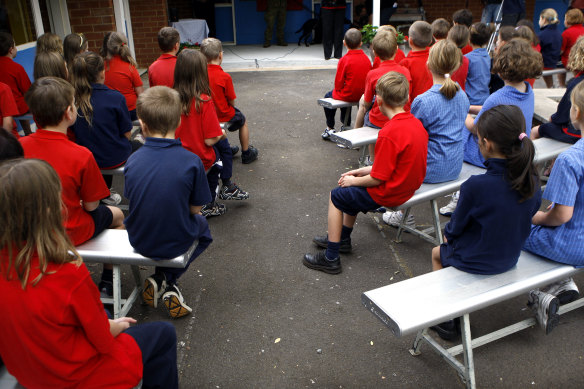Opinion
Let’s not fixate on co-ed v single-sex. Both can elevate our kids – or fail them
By Kellie Burns, Jessica Kean and Helen Proctor
There has been no shortage of debate about co-ed and single-sex schools over the past 18 months. The NSW government has announced several mergers of formerly single-sex schools as part of its promise that every family in the state will have the option of choosing a co-ed public high school by 2027. Several Catholic schools and two prominent all-boys independent schools have also announced they will move to co-ed.
The two most recent government school mergers were announced last Wednesday. Asquith Girls and Asquith Boys in Hornsby will become separate standalone co-ed campuses with distinct catchment zones, while Moorefield Girls and James Cook Boys Technology High in Kogarah will merge into a single co-ed school.

Most children start in co-ed schools. The focus for a high school needs to be on its culture, whether it’s co-ed or single-sex.Credit: Glen McCurtayne
NSW Education Department consultation data, reported in the Herald, found most prospective parents in both neighbourhoods favoured co-education. In both cases, however, the majority of current parents (and staff) at the girls’ schools were opposed to the change.
Some of the opposition to the restructures is probably from parental concern about the disruption that any large change to a school can cause. Other parents have expressed frustration that they are no longer getting what they thought they signed up for, whether in terms of gender, school size or school structure.
In contemporary Australia, parents can find the pressure to choose the “right” school for their child stressful. This stress is a product of the choice culture that characterises schooling across the public and private sectors.
Schooling policy at federal and state levels positions parents as consumers making choices between different school products. More choice is often seen as a good thing, but this choice culture creates the illusion that the quality of a child’s education is the responsibility of parents, rather than the schooling system overall. This burden can weigh heavily, especially as school choice is often constrained by financial and geographic factors beyond parents’ control.
The current debates suggest gender remains a major consideration for many parents. The Herald reported many parents at the girls’ schools earmarked for change were concerned about the impact of co-education on their daughters’ achievement, as well as their social and emotional safety. But these concerns are not new. In the 1980s, a wave of feminist research into co-education raised questions about the prioritisation of boys’ needs and interests over those of girls in co-educational schools of the time. In the 1990s, the “what about the boys?” debate led to state and federal inquiries into the possibility that it was now boys rather than girls who were being “left behind” in Australian classrooms.
At the heart of these debates is the question of which schooling system achieves the best academic or social outcomes for boys and girls. There is a persistent belief among parents that girls do better in single-sex schools while boys do better in co-ed settings. However, there is no definitive evidence that one produces better results than the other.
Schools are complex organisations with many confounding variables. For example, while the remaining NSW all-girls government schools produce solid academic outcomes, it is rarely noted that most of these are in middle-class areas. Class is seldom raised in debates about co-education, despite decades of evidence of correlations between family wealth and academic success.
Another common defence of all-girls schools is that they shelter girls from the broader gendered climate, providing them a space to flourish free from the stereotypes that might otherwise restrain them. Some girls’ schools pitch themselves as helping to break gender barriers by offering more opportunities for leadership and STEM (science, technology, engineering and mathematics).
Implicit also, perhaps, is a sense that girls’ schooling provides respite from everyday sexism. This concern is understandable, given the disproportionate rates of gender-based violence experienced by girls and LGBTIQ+ youth, and troubling reports of the influence of popular misogynist influencers among young men.
However, girls’ schools do not necessarily protect their students from harsh gender norms or gender-based violence. There is a long history of girls’ schools reinforcing the social limitations of gender. Many of the girls’ high schools in NSW were originally founded as domestic science schools, established in the 1930s to prepare girls for a future as housewives. Girls’ schools before the 1970s typically offered very limited career advice, and many still speak to their students about the importance of “lady-like behaviour”. Girls themselves will often reinforce limiting norms to do with sexuality, gender and femininity.
It is not the gender enrolment so much as the gender culture and values of a school that make the difference. Many girls’ schools have embraced a mandate for supporting girls to overcome limitations placed on them by culture, but co-ed settings are just as capable of taking up that mantle. By opening their doors to all children, co-ed schools are well placed to support and extend students, regardless of gender. Students’ learning can be approached beyond segregated gender groups, focusing instead on shared interests and aptitudes.
To be clear: this is not an automatic outcome of co-education. Schools are part of the broader gendered world we all live in, and all schools will reproduce that culture if they do not actively work to change it. A whole-of-school approach to gender equality and diversity ensures that all facets of a school prioritise equity and challenge stereotypes and norms, from daily teaching to a school’s ethos, policies and partnerships. These types of schools – and they do exist – are places where all children can thrive.
Kellie Burns is a senior lecturer in education, Jessica Kean is a lecturer in gender and cultural studies, and Helen Proctor is a professor in education, all at the University of Sydney.